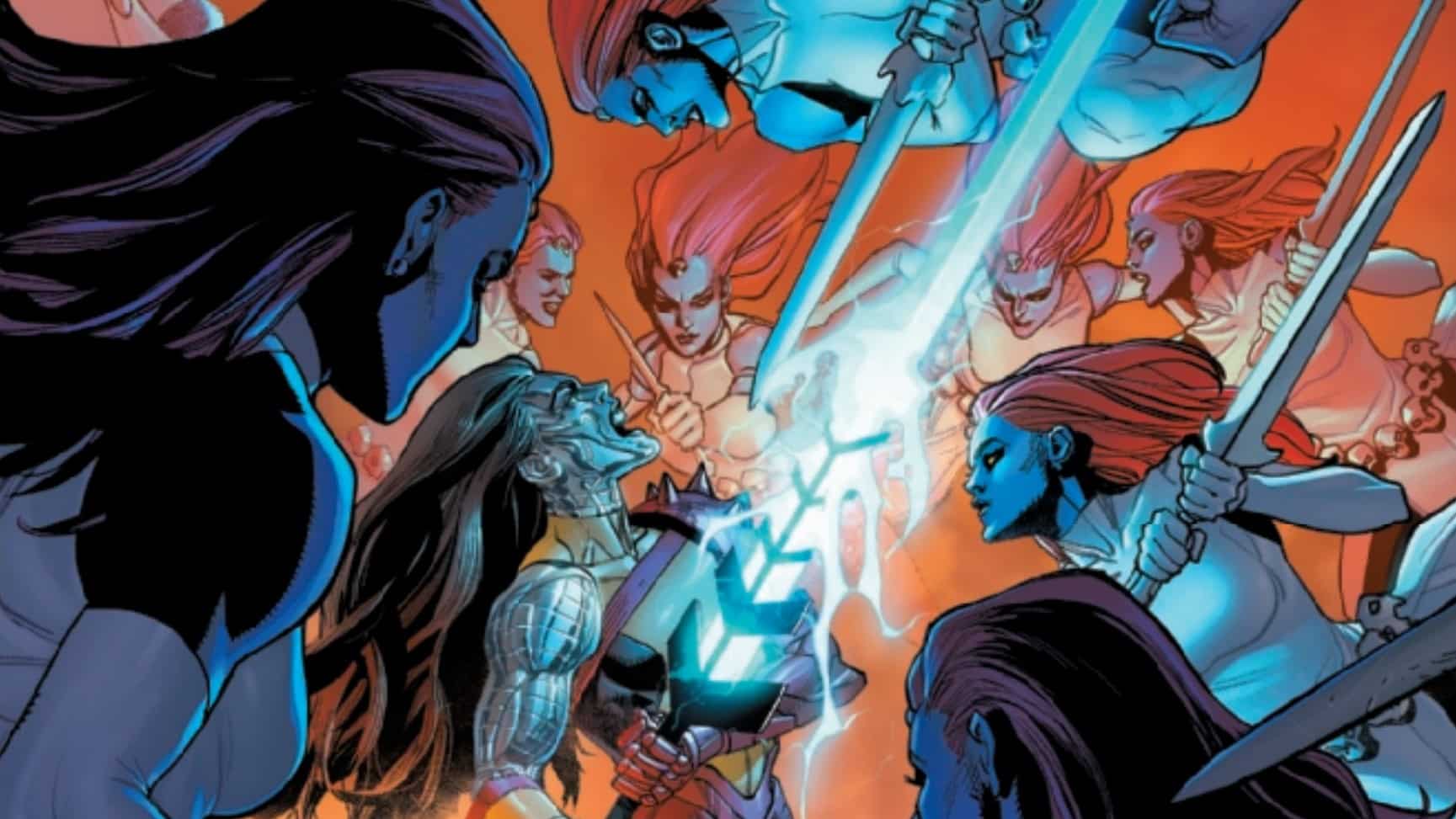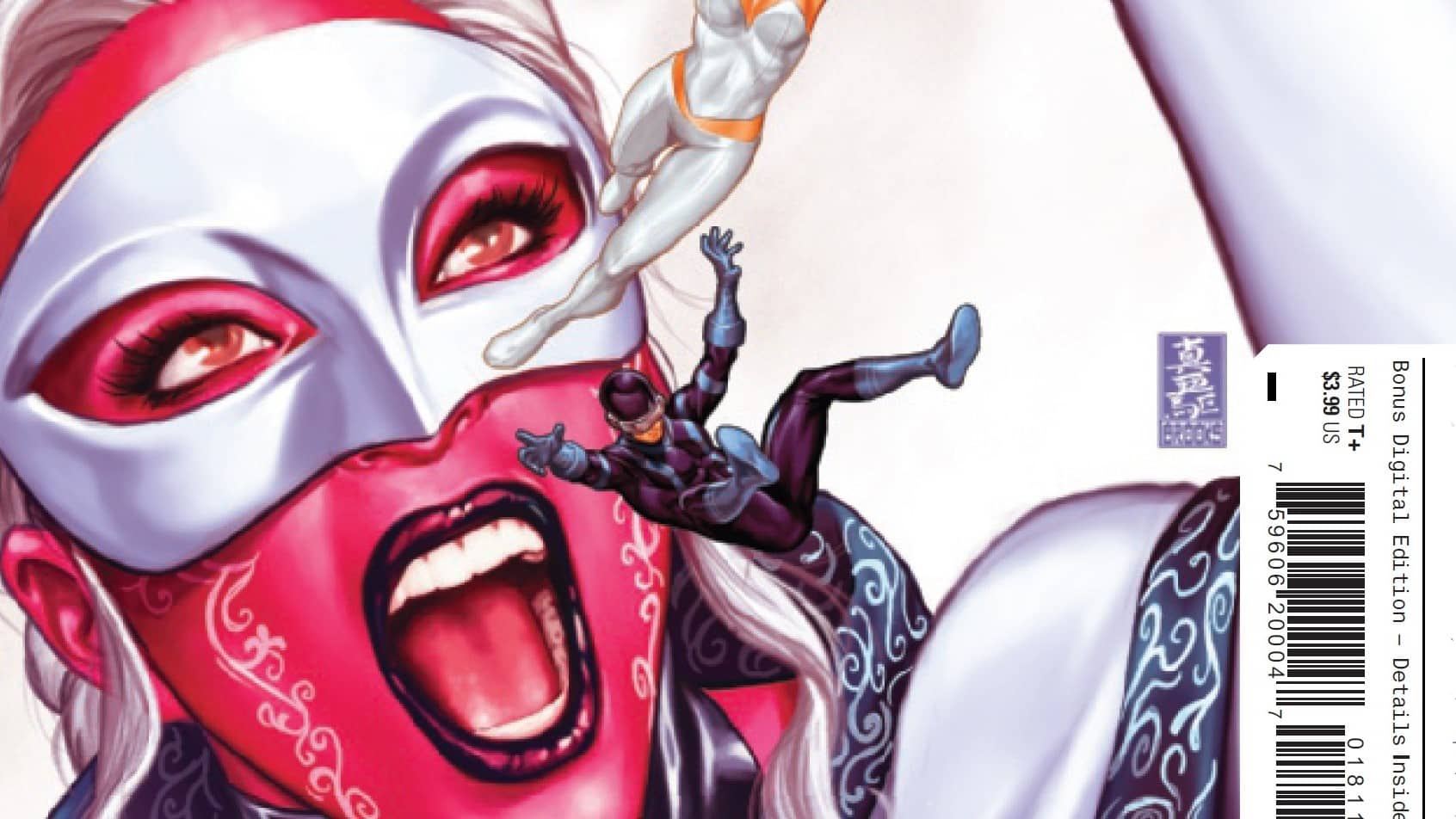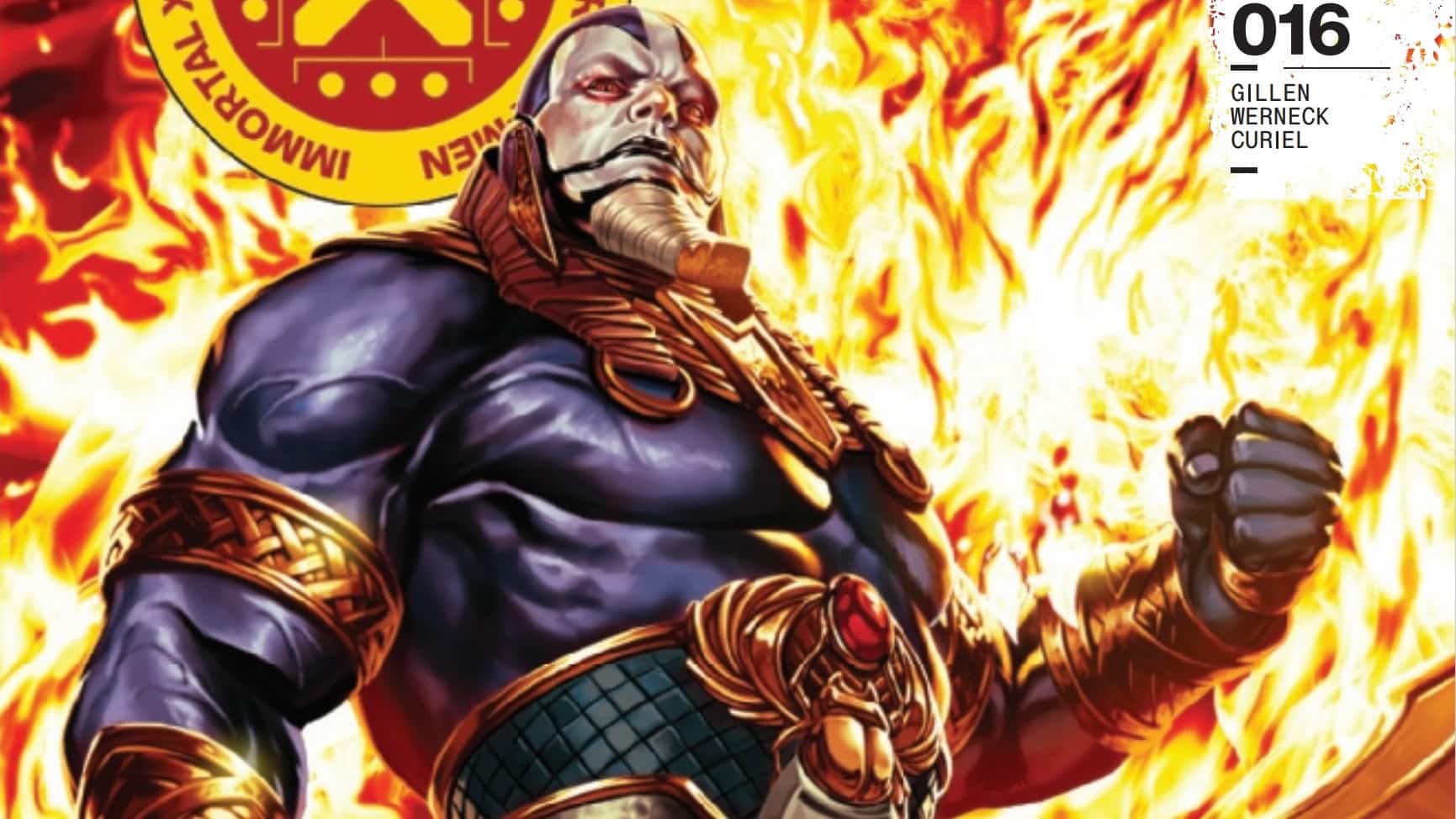Boldly go 100 years into the future of Sinister’s utopia-turned-prison in Immoral X-Men #2, as Sinister Prime makes his bid for freedom amid mutantkind’s ascent to galactic dominance! Written by Kieron Gillen, drawn by Andrea Di Vito, colored by Jim Charalampidis and lettered by Clayton Cowles.
Austin Gorton: Space, the final frontier. These are the voyages of the Starship Marauder; its five-year mission, to seek out Moira MacTaggert clones and strange genetic modifications, to boldly go where no Sinister has gone before: a mission for the well-being of Krakoa itself!
Mark, you’re part of the regular ComicsXF Star Trek beat, reviewing both the ongoing IDW comic book and the current season of Picard; are you feeling a little like someone got some peanut butter in your chocolate this week?
Mark Turetsky: You know, both Marvel and Trek have at their center a charismatic salesman who embraced their public persona as a visionary storyteller, who may have also done some highly questionable things in their rise to the top. Let’s explore this strange new world of +100!
The Rock Upon Which I Build

Mark: The issue opens with Hope and Exodus getting ready to destroy the last vestiges of the Kree-Skrull alliance and the Rigellians. Hope has taken on Exodus’ power, as has become her habit, and uses the tremendous amount of faith the mutant fleet has in her to launch “L bombs” (a chimera of Lila Cheney, Firestar, Harry Leland and Micromax) that destroy entire planets in one go. While much of the issue has shades of Star Trek, this sequence put me in mind of another sci-fi franchise. No, I don’t mean that Hope can take out an entire system like Starkiller Base. I mean she’s the center of a vast stellar religion, using that religious fervor with the intention of genocide. That, to me, is pretty Warhammer 40K.
Austin: This could just be from the fact that I’ve been playing too much Marvel Snap, but Hope’s Exodus-aided power-up and the way the L-Bomb’s suite of powers worked in concert with each other reminded me of the game and the way certain card combos work together to create an effect bigger than the individual one (I am almost certainly playing too much Marvel Snap).
Hope of this era is starting to resemble her dad in more than just attitude, sporting a cybernetic arm and one of those robotic half-faces that were all the rage in the ’90s; after the credits, we learn this is because Hope has left chunks of herself back on Krakoa, enabling her to basically be in two places at once: powering the resurrection engine AND leading mutantkind’s army into the cosmos. It is a very Sinister solution to the problem, something Hope — who, if this issue has a POV character, is it — points out via her internal monologue.
Mark: It’s amazing to see how Sinister Hope has gone from agitating for a spot on the council to represent The Five to not even wanting to be part of The Five. To have in fact, replicated The Five and turned resurrection into a factory farm process. What had started as a revered, quasi-religious ceremony (complete with Storm reintroducing the resurrected mutant to the rest of Krakoa) has now become industrial, ho-hum, dehumanized, as it were. And now all of that religious reverence has been heaped on Hope alone instead. Power corrupts, huh?
Austin: Indeed. The industrialization of resurrection is one of the more subtle ways the influence of the Victorian Era Sinister is expressing itself in this reality. Of course, for all Hope’s influence, she is still largely dependent on the power of others, something that becomes clear when Exodus pulls a Judas and turns on his messiah. Kieron Gillen and Andrea Di Vito do that trick where they depict a sequence one time, showing the “right” way things happen, then repeat a similar sequence later in the issue, only this time it goes wrong relative to what happened the first time. It’s a neat technique to both show how efficient Hope’s war machine has become, and yet also, just how vulnerable she is if one cog in that machine slips loose.
Mark: She’s bought into her own hype. And she’s done it to the degree that she’s completely blind to the fact that she’s made herself redundant by removing herself from resurrection so she can destroy strange new worlds. They don’t really give us a headcount of how many members of the Quiet Council remain, but it looks like, at the start of this issue, there’s only Emma, Xavier, Hope, Exodus and Sinister. The corridors of power are narrowing.
As for Exodus’ reasons for wanting her dead, keep in mind that he made do with an absent messiah for the first millennium of his life (OK, yes, he was asleep for most of that), and he’s only been united with Hope for 100 or so years at this point. In their Sinister incarnations, Hope takes Exodus for granted, and I sense a certain resentment in Exodus. He doesn’t explicitly come out and say it, but his “I am not with you — you are just a girl with a gun” line belies a deep-seated resentment. Either that or it’s a plain statement of the fact of what he’s done and how her powers work. Even so, even before they were taken over by Sinister, we can see the beginnings of this dynamic take root. Plain ol’ Hope does take Exodus’ support for granted. Exodus doesn’t always agree with what she asks of him. The real question is, would something like this happen without the implantation of the Sinister genes?
And while you make the Judas comparison, Exodus is also serving as her Simon “The Rock” Peter. He says, “I am your church,” echoing Jesus’ telling Simon that he will be the rock on which his church is built. But in this case, Simon is taking that power, instead of being granted it.
Righteous Pagans

Austin: Speaking of biblical allegories, the big turn of this issue, beyond Exodus’ betrayal of Hope, is Sinister Prime having a bit of a come-to-Jesus moment. Upon on the completion of his latest chimera (more on her below), Sinister realizes his utility to the council (the thing keeping him alive following his encounter with Emma last issue) is quickly coming to an end, and therefore he’s in danger (Here, Sinister is explicitly displaying more self-awareness than Hope). But the turn itself is seemingly prompted by an encounter with Mother Righteous, the “magic” aspect of the four Sinisters created by the original Nathanial Essex.
What results is the kind of conversation filled with vague inferences and cryptic commentary you’d expect from two Sinisters having a conversation with each other, and it’s not entirely clear to me what, exactly, Mother Righteous says that spurs Sinister’s later actions in the issue. But then, I’ve only been giving Si Spurrier’s Legion of X a cursory read, at best.
Mark: Well, I for one am grateful that we got that magical data page from Mother Righteous, explaining who all the Sinisters are, for those who haven’t been keeping up with all of the books, or at least reminding us who the players are in this crossover. It’s also nice that Sinister learns all of this stuff at long last, since we the readers have been better informed on the different card suits thing for a while now.
Austin: I’m curious to see if Sinister will retain his memories of all this when the timeline inevitably resets, or if we’re going to go back to knowing more than Sinister. Hopefully, some measure of character growth/change will occur, otherwise a lot of this will be for naught.
What Does God Need With A Starship?

Austin: Speaking of character growth, our guy Sinister executes a pretty significant face turn in this issue. But first, we get the return of Rasputin IV, one of the first chimera who caught the attention of readers back in Powers of X #1. Notably, Sinister asserts to the council that she’s been essentially programmed to be heroic, saying a leader like her needs to be such a thing to succeed and to ensure she doesn’t pull an Exodus-on-Hope and betray them. Basically, she can’t be a Sinister. But per usual, Sinister has some ulterior motives at work.
Mark: Sinister’s gotta Sinister. And he’s had 100 or so years to plan his exit strategy alongside his designing Rasputin. And since he’s fond of including trojan horses in his design, why not accomplish a little of both? And while last month we had Sinister create a disposable clone of himself to bounce his ideas off of, here he’s created an actual companion and ally. He tells Rasputin he destroyed the paradise that was Krakoa to pursue his own twisted goals. He’s grown a sense of humility and shame in the intervening 90 years.
Austin: It was honestly a little surprising to see him talk so reverently about the Krakoa of yore (that he, you know, helped corrupt and destroy). I’m not sure the turn is sold entirely — that the council is out to get him is hardly new info, and the Mother Righteous conversation was entirely too cryptic to reveal much — but I guess we chalk that up to the passage of time, the need to move the story along and the limitations of a smaller event like this that is also jumping significantly into different farflung eras.
At any rate, the newly heroic Sinister and the designed-to-be heroic Rasputin commandeer the new Marauder, a spaceship created to seek out new life and new civilizations find new worlds for mutants to conquer/destroy, and set out to find Sinister’s Moiras in order to reset the timeline and bring back the old, better Krakoa. Obviously, this is the point where the issue just becomes a full-on Star Trek comic.
Mark: The Proteus torpedoes are a play on proton torpedoes, Rasputin calls for them to go to “warp factor X,” the layout of the bridge is clearly based on the Enterprise, even the cheeky joke about going on a five-year mission (that we know will likely take 900 years, a nod to Trek’s ongoing mission?), it’s all very Star Trek. Even the trope of stealing the Enterpri– err, the Marauder is from Star Trek III: The Search for Spock. But this obvious pastiche hints at some of the subtler work throughout the issue. If Star Trek presents humanity’s future at its most hopeful, the Sinister Council’s conquest of the galaxy presents the bleakest version of that future, something akin to the Mirror Universe’s Terran Empire, or the alternate timeline’s Confederation.
But what this reminds me of the most is the beginning of the Shi’Ar saga from early in the Claremont run, specifically Uncanny X-Men #105, where the visual motif hadn’t yet transitioned to being Star Wars and so the visual language that Cockrum was pulling from was Star Trek.
Austin: Ah, good old Shi’ar Captain K’rk! Even Di Vito gets in on the act, ending the issue with a classic Trek pose as Rasputin assumes the captain’s chair while Sinister is poised over her shoulder, hands clasped behind him. In addition to the juxtaposition with classic Trek ethos, it also underscores Sinister’s face turn, ending with him at the arm of his heroic captain, setting out to right wrongs (his wrongs, but still). I’m not sure if the issue fully earns the turn, but it certainly does its best to sell it in its closing moments.
Selected Sinister Sentiments
- Sad to see Mystique get killed in a data page, but that’s likely going to happen on-panel in the next issue of Storm and the Brotherhood.
- Sinister to Mother Righteous: “Coming out of the shadows, being ominous and hinting at a bigger story? My dear I invented that game.”
- Looking back at Immortal X-Men #3 and the chart of possible Moira save point futures, we’re in The Empire of the Red Diamond, so I’m guessing +1000 will be The Storm System.






